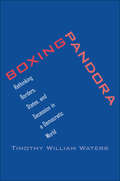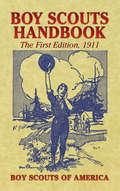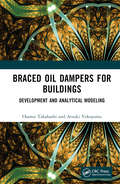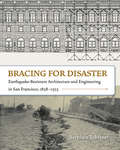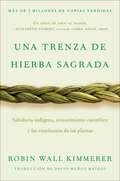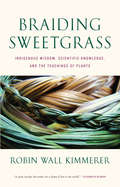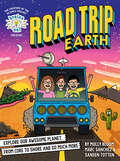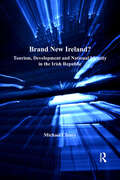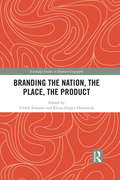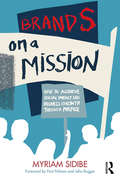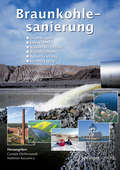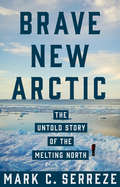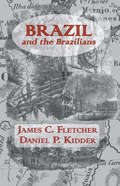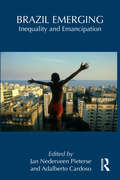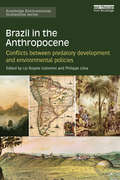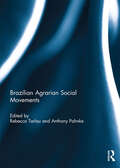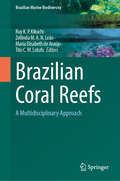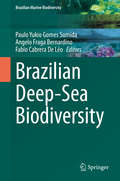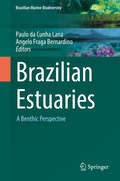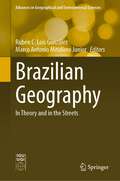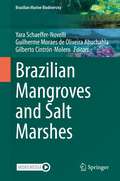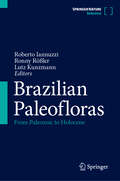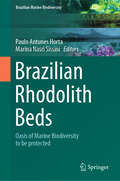- Table View
- List View
Boxing Pandora: Rethinking Borders, States, and Secession in a Democratic World
by Timothy William WatersA timely and provocative challenge to the foundations of our global order: why should national borders be unchangeable? The inviolability of national borders is an unquestioned pillar of the post–World War II international order. Fixed borders are believed to encourage stability, promote pluralism, and discourage nationalism and intolerance. But do they? What if fixed borders create more problems than they solve, and what if permitting borders to change would create more stability and produce more just societies? Legal scholar Timothy Waters examines this possibility, showing how we arrived at a system of rigidly bordered states and how the real danger to peace is not the desire of people to form new states but the capacity of existing states to resist that desire, even with violence. He proposes a practical, democratically legitimate alternative: a right of secession. With crises ongoing in the United Kingdom, Spain, Ukraine, Iraq, Syria, Sudan, and many other regions, this reassessment of the foundations of our international order is more relevant than ever.
Boy Scouts Handbook: The First Edition, 1911 (Dover Books On Americana Ser.)
by Boy Scouts of AmericaRead by presidents, scientists, and national heroes, the Boy Scouts Handbook has been used by generations of American youths. Filled with practical advice for everyone, the book contains everything from safety tips on swimming and instructions for putting up a tent to directions for making an aquarium and pointers on how to identify common North American trees.More than 200 figures and illustrations accompany valuable information on woodcrafting, camping, sailing, hiking, health and endurance, and providing first aid. But more than just a guide to outdoor life, the handbook also offers timeless observations on politeness, patriotism, and good citizenship.As useful and valid today as it was when first published nearly 100 years ago, the Boy Scouts Handbook will delight Americana enthusiasts as much as it will be treasured by collectors and nature lovers.
Boy, Were We Wrong About the Weather!
by Kathleen V. KudlinskiHurricaines, Thunder and Lightning, climate change, Wind, Rain. We were once wrong about all of these. But are we right now? Find out in the latest book in this award-winning series. Ancient Sumerian warriors used to think that lightning and thunder were caused by an angry weather god —boy, were they wrong! Even today once common ideas about how our weather and climate work are changing as new discoveries are being made. Kathleen V. Kudlinski and Sebastià Serra team up to debunk old—and sometimes silly—myths about weather and to celebrate the pioneers that made meteorology the science it is today. This award-winning series is especially meant for the budding scientist and is perfect for children who are fascinated by the natural world and how it works.
Braced Oil Dampers for Buildings: Development and Analytical Modeling
by Osamu Takahashi Atsuki YokoyamaThe high damping force of oil damper vibration control systems in buildingsoffers relative safety during earthquakes and at a low environmentalcost. The oil damper is connected using braces in series and is installed withpins to the building structure, which minimizes the impact on the buildingstructure and allows installation and removal with ease.This is the first book detailing experimental work and cases of the use ofoil dampers in buildings. It shows their effectiveness by detailing the testingand analysis of buildings with them placed at braced positions, exposed tosmall amplitude vibration, and without them.• The only comprehensive presentation of oil damper vibration control• Covers analysis and design, with case studies and details of testingand experimental resultsThe book is organized systematically to suit students and junior professionalsin structural design as well as more specialist engineers. An additionalPython code sample is available online for learning the behaviors of oildampers (Jupyter Notebook environment required).Osamu Takahashi is a professor at Tokyo University of Science, founderof Science Kozo Inc., and an advisor to the New International StructuralDesign & Engineering Challenge Association, in Japan.Atsuki Yokoyama works in the Research and Development Departmentof Sanwa Tekki Corporation and has a PhD in Engineering from TokyoUniversity of Science.
Bracing for Disaster: Earthquake-Resistant Architecture and Engineering in San Francisco, 1838–1933
by Stephen Tobriner&“The first history of seismic engineering in San Francisco . . . spiced with survivor and eyewitness accounts. &”—Midwest Book Review For the past one hundred and fifty years, architects and engineers have quietly been learning from each quake and designing newer earthquake-resistant building techniques and applying them in an ongoing effort to save San Francisco. Bracing for Disaster is a fresh appraisal of a city responding to repeated devastation. In the language of a skilled teacher, Tobriner examines what really happened during the city&’s earthquakes—which buildings were damaged, which survived, and who were the unsung heroes. Filled with more than two hundred photographs, diagrams, and illustrations, this is a revealing look at the history of buildings by a true expert, and it offers lessons not just for San Francisco but for any city beset by natural disasters. &“The real saga is how a fast-growing city grapples with the reality that it has more to worry about than fires and fog. The core of the story is fairly technical, rooted in the crude intuitive ways in which builders reacted to a seismic threat they could neither measure nor define. But Tobriner crafts the story well.&”—SFGate
Bracing for Disaster: Earthquake-resistant Architecture and Engineering in San Francisco, 1838-1933
by Stephen TobrinerFor the past one hundred and fifty years, architects and engineers have quietly been learning from each quake and designing newer earthquake-resistant building techniques and applying them in an ongoing effort to save San Francisco. Bracing for Disaster is the first history of seismic engineering in San Francisco. In the language of a skilled teacher, Tobriner examines what really happened in the city's earthquakes—which buildings were damaged, which survived, and who were the unsung heroes—in a fresh appraisal of a city responding to repeated devastation. Filled with more than two hundred photographs, diagrams, and illustrations, this is a revealing look at the history of buildings by a true expert, and it offers lessons not just for San Francisco but for any city beset by natural disasters.
Braiding Sweetgrass / Una trenza de hierba sagrada (Spanish edition): Sabiduría indígena, conocimiento científico y las enseñanzas de las plantas
by Robin Wall KimmererUno de los libros más importantes de nuestros tiempos, que nos invita a descubrir un nuevo lenguaje para comunicarnos con la naturaleza y recibir sus enseñanzas. Como mujer indígena, Robin Wall Kimmerer es heredera de un valioso legado que considera a los animales y las plantas nuestros mejores maestros. Como botánica, se ha valido del rigor científico para estudiar mejor la naturaleza. Y como madre, profesora y escritora, ha dedicado su vida a conjugar ambas perspectivas para abogar por un despertar de la consciencia ecológica que reconozca y celebre nuestra profunda conexión con otras formas de vida.En Una trenza de hierba sagrada, la autora entreteje experiencias y saberes en una serie de relatos iluminadores y emotivos que nos inspiran a fortalecer nuestra relación sagrada con la Madre Tierra. Cada capítulo es una magnífica lección de gratitud y reciprocidad, que nos recuerda que, si ofrecemos nuestros dones al mundo y lo ayudamos a sanar, este nos retribuirá con la armonía y el bienestar que tanto anhelamos.Bestseller del New York TimesBestseller del Washington PostBestseller del Los Angeles Times«Mejor Colección de Ensayos de la Década» según Literary Hub———A masterpiece of our times, inviting us to discover a new language for communicating with nature and receiving its lessons.As a Native American woman, Robin Wall Kimmerer is the heir to a valuable legacy that views animals and plants as our greatest and oldest teachers. As a botanist, she leverages scientific knowledge to better understand nature. And as a mother, teacher, and writer, she has dedicated her life to blending these perspectives and advocate for an awakening of ecological consciousness that acknowledges and celebrates our deep connection with other forms of life.In Braiding Sweetgrass, the author weaves together experiences and knowledge in a series of illuminating and emotional stories that inspire us to reinvigorate our sacred relationship with Mother Earth. Each chapter offers a magnificent lesson in gratitude and reciprocity, reminding us that if we contribute our gifts to the world and help it heal, it will reward us with the harmony and wellness we are yearning for.A New York Times BestsellerA Washington Post BestsellerA Los Angeles Times BestsellerNamed a “Best Essay Collection of the Decade” by Literary Hub
Braiding Sweetgrass: Indigenous Wisdom, Scientific Knowledge And The Teachings Of Plants
by Robin Wall KimmererAs a botanist, Robin Wall Kimmerer has been trained to ask questions of nature with the tools of science. As a member of the Citizen Potawatomi Nation, she embraces the notion that plants and animals are our oldest teachers. In Braiding Sweetgrass, Kimmerer brings these two lenses of knowledge together to take us on “a journey that is every bit as mythic as it is scientific, as sacred as it is historical, as clever as it is wise” (Elizabeth Gilbert). Drawing on her life as an indigenous scientist, and as a woman, Kimmerer shows how other living beings―asters and goldenrod, strawberries and squash, salamanders, algae, and sweetgrass―offer us gifts and lessons, even if we've forgotten how to hear their voices. In reflections that range from the creation of Turtle Island to the forces that threaten its flourishing today, she circles toward a central argument: that the awakening of ecological consciousness requires the acknowledgment and celebration of our reciprocal relationship with the rest of the living world. For only when we can hear the languages of other beings will we be capable of understanding the generosity of the earth, and learn to give our own gifts in return.
Brains On! Presents...Road Trip Earth: Explore Our Awesome Planet, from Core to Shore and So Much More
by Molly Bloom Marc Sanchez Sanden TottenThe creators of the award-winning science podcast for kids, Brains On!, take readers on a humorous, highly illustrated, fact- and fun-filled journey through Earth—from the core, to the outer atmosphere, and everywhere in between. Perfect for STEM enthusiasts!Did you ever wonder why volcanoes erupt? Or why the ocean is salty? How about why no two snowflakes are the same?Embark on an epic road trip to find the answers to these burning questions and more! The Brains On! team is traveling from deep inside the earth, through the oceans, the land, the clouds, and even into the outer atmosphere in their high-tech ride—to uncover the coolest facts, strangest mysteries, and most incredible marvels of our planet.Packed with scientific research, mind-boggling trivia, and laugh-out-loud jokes, this highly illustrated fact-filled exploration of the earth promises a brain-bending, jaw-dropping, belly-laughing good time that curious kids and budding scientists won&’t be able to resist.Turn your BRAINS ON! with more books and check out:Brains On! Presents...It's AliveBrains On! Presents...Earth Friend Forever
Brand New Ireland?: Tourism, Development and National Identity in the Irish Republic (New Directions In Tourism Analysis Ser.)
by Michael ClancyWhat role does the state have over national development within an increasingly globalized economy? Moreover, how do we conceive 'nationality' during periods of rapid economic and social change spurred on by globalization? By examining tourism in the Republic of Ireland over the past 20 years, Michael Clancy addresses these questions of national identity formation, as well as providing a detailed understanding of the political economy of tourism and development. He explores tourism's role in the 'Celtic Tiger' phenomenon and uses tourism as a lens for observing national identity formation in a period of rapid change.
Branding the Nation, the Place, the Product (Routledge Studies in Human Geography)
by Ulrich Ermann Klaus-Jürgen HermanikBranding is a profoundly geographical type of commodification process. Many things become commodities that are compared and valuated on markets around the globe. Places such as cities or regions, countries and nations attempt to acquire visibility through branding. Geographical imaginations are evoked to brand goods and places as commodities in order to show or create connections and add value. Yet, not all that is branded was originally intended and created for markets. This volume aims to broaden current understanding of branding through a series of contributions from geography, history, political studies, cultural, and media studies, offering insight into how ordinary places, objects and practices become commodities through branding. In so doing, the contributions also show how nation, place and product as targets of branding can be seen as intertwined. To discuss these forms of branding, book chapters refer to states, cities, holiday destinations, food malls, movies, dances, post stamps and other items that serve as brands and/or are branded. The book will be of interest to students and scholars in geography, sociology, history, cultural studies and business studies who would like to gain an understanding of the intricate and surprising ways in which things, places, and cultural practices become brands.
Brands on a Mission: How to Achieve Social Impact and Business Growth Through Purpose
by Myriam SidibeBrands on a Mission explores the importance of creating a performance culture that is built on driving impact through purpose, and the type of talent required to drive these transformational changes within companies – from CEO to brand developers. Using evidence from interviews and stories from over 100 CEOs, thought leaders and brand managers, the book presents an emergent model that organisations can follow to build purpose into their growth strategy – and shows how to bridge the gap between Brand Say and Brand Do. Readers will learn from the real experts in the field: how Paul Polman, former CEO of Unilever, built purpose into the DNA of his company; what keeps Alan Jope (new CEO, Unilever) and Emmanuel Faber (CEO, Danone) awake at night; and how brand developers from Durex, Dove, Discovery and LIXIL have made choices and the reasons behind them. In this book you will learn how a soap brand Lifebuoy taught one billion people about hygiene, how a beer is tackling gender-based violence, and how a toothpaste is tackling school absenteeism amongst many others. Renowned experts like Peter Piot (Director, London School of Health and Tropical Medicine), Michael Porter (Professor, Harvard School of Business), Jane Nelson (Director, Corporate Responsibility Initiative, Harvard Kennedy School) and Susie Orbach (leading feminist and formerly professor, London School of Economics) also share examples, data and their everyday experiences of helping corporates create a culture of purpose. And leading NGOs and UN experts like Lawrence Haddad (Executive Director, GAIN) and Natalia Kanem (Executive Director of UNFPA) will recount how the public and private sector have worked together to create an accelerated path to reaching the Sustainable Development Goals by 2030. The book provides a clear pathway of how to take brands through the journey of developing impactful social missions and driving business growth, and is an essential guide for both managers and students alike.
Braunkohlesanierung: Grundlagen, Geotechnik, Wasserwirtschaft, Brachflächen, Rekultivierung, Vermarktung
by Carsten Drebenstedt Mahmut KuyumcuAllein im Raum Halle/Leipzig und der Lausitz wurden etwa 30 Braunkohlentagebaue und 90 Kraftwerks- und Veredlungsstandorte seit Anfang der 1990er Jahre saniert mit dem Ziel, Umweltsch#65533;den zu beseitigen und die Landschaft wiederherzustellen. Vertreter aus Beh#65533;rden und Hochschulen, Sanierungsunternehmen und Planungsb#65533;ros erl#65533;utern die eigens daf#65533;r entwickelten Technologien, sie beschreiben die Managementstrukturen und ihre Erfahrungen bei der Sanierung des stillgelegten Braunkohlenbergbaus. Mit zahlreichen Abbildungen und Tabellen sowie einem Glossar.
Brave New Arctic: The Untold Story of the Melting North (Science Essentials)
by Mark C. SerrezeAn insider account of how researchers unraveled the mystery of the thawing ArcticIn the 1990s, researchers in the Arctic noticed that floating summer sea ice had begun receding. This was accompanied by shifts in ocean circulation and unexpected changes in weather patterns throughout the world. The Arctic's perennially frozen ground, known as permafrost, was warming, and treeless tundra was being overtaken by shrubs. What was going on? Brave New Arctic is Mark Serreze's riveting firsthand account of how scientists from around the globe came together to find answers.In a sweeping tale of discovery spanning three decades, Serreze describes how puzzlement turned to concern and astonishment as researchers came to understand that the Arctic of old was quickly disappearing--with potentially devastating implications for the entire planet. Serreze is a world-renowned Arctic geographer and climatologist who has conducted fieldwork on ice caps, glaciers, sea ice, and tundra in the Canadian and Alaskan Arctic. In this must-read book, he blends invaluable insights from his own career with those of other pioneering scientists who, together, ushered in an exciting new age of Arctic exploration. Along the way, he accessibly describes the cutting-edge science that led to the alarming conclusion that the Arctic is rapidly thawing due to climate change, that humans are to blame, and that the global consequences are immense.A gripping scientific adventure story, Brave New Arctic shows how the Arctic's extraordinary transformation serves as a harbinger of things to come if we fail to meet the challenge posed by a warming Earth.
Brazil And Brazilians: Portrayed In Historical And Descriptive Sketches (1857)
by FletcherFirst published in 2006. Routledge is an imprint of Taylor & Francis, an informa company.
Brazil Emerging: Inequality and Emancipation (Routledge Studies in Emerging Societies #3)
by Jan Nederveen Pieterse Adalberto CardosoThis volume is a critical inquiry into the social project and socioeconomic realities of emerging Brazil, a country that faces profound changes. A team of acknowledged specialists on Brazil’s complex configuration addresses state policies, social dynamics and economic constraints and opportunities for emancipation. Chapters adopt long-run perspectives on the development of the Brazilian welfare state, limits and opportunities for emancipation in the labor market, the scope and depth of social policies such as "Bolsa Família" and Rio’s Peacemaking Police Units (UPP), social movements - in particular, the Movement of the Landless (MST) - cultural policies at the federal level, the role of media in the country’s democratization project, and how two important commodities (sugar and oil) shape the identities of blacks and whites in Bahia. This book is essential reading for all those interested in understanding what kind of Brazil has acquired a prominent global position and what hurdles it faces to consolidate its position as a global player.
Brazil in the Anthropocene: Conflicts between predatory development and environmental policies (Routledge Environmental Humanities)
by Liz-Rejane Issberner Philippe LénaBrazil is considered one of the world’s most important environmental powers. With a continental territory containing almost 70 per cent of the Amazon rainforest, along with a rich biodiversity and huge amount of natural resources, its geopolitical role in environmental decisions is crucial to ongoing global negotiations surrounding climate change. Development policies based on extraction and exportation of raw materials by the mining and agribusiness sectors threaten the global environmental balance and the long-term sustainability of Brazil’s economy. Brazil in the Anthropocene examines Brazil's role within the global ecological crisis and considers how national and international policy is influenced by the interdependence of social, political, ethical, scientific and economic factors in the modern age. With chapters from a diverse range of international scholars this interdisciplinary volume will be of great interest to students and scholars of environmental politics, environmental sociology and the environmental humanities.
Brazilian Agrarian Social Movements
by Rebecca Tarlau and Anthony PahnkeContradictions between impressive levels of economic growth and the persistence of poverty and inequality are perhaps nowhere more evident than in rural Brazil. While Brazil might appear to be an example of the potential harmony between large-scale, export-oriented agribusiness and small-scale family farming, high levels of rural resistance contradict this vision. In this volume, individual contributions from a variety of researchers across the field highlight seven key characteristics of contemporary Brazilian resistance that have broader resonance in the region and beyond: the growth of international networks, the changing structure of state–society collaboration, the deepening of territorial claims, the importance of autonomy, the development of alternative economies, continued opposition to dispossession, and struggles over the meaning of nature. By analyzing rural mobilization in Brazil, this collection offers a range of insights relevant to rural contention globally. Each contribution in this title increases our understanding of alternative agricultural production, large-scale development projects, education, race and political parties in the contemporary agrarian context. This book was previously published as a special issue of the Journal of Peasant Studies.
Brazilian Coral Reefs: A Multidisciplinary Approach (Brazilian Marine Biodiversity)
by Ruy K. P. Kikuchi Maria Elisabeth de Araújo Zelinda M. A. N. Leão Tito M. C. LotufoThe Brazilian coral reefs form structures significantly different from the well-known reef models, as follows: they have a growth form of mushroom-shaped coral pinnacles called "chapeirões"; they are built by a low diversity coral fauna rich in endemic species, with most of them relic forms dating back to the Miocene; and the nearshore bank reefs are surrounded by siliciclastic sediments. The reefs are distributed into four major sectors along the Brazilian coast: the northern, the northeastern, and the eastern regions, and the oceanic islands, but certain isolated coral species can be found in warmer waters in the embayment of the southern region. There are different types of bank reefs, fringing reefs, isolated "chapeirões" and an atoll present along the Brazilian coast. Corals, milleporids, and coralline algae build the rigid frame of the reefs. The areas in which the major coral reefs occur correspond to regions in which nearby urban centers are experiencing accelerated growth, and tourism development is rapidly increasing. The major human effects on the reef ecosystem are mostly associated with the increased sedimentation due to the removal of the Atlantic rainforest and the disposal of industrial and urban effluents. Fishing resources are seriously declining due to pollution and overfishing, and this reduction impacts artisanal fishers, who are impoverished and face food security risks. The effects of warming oceanic waters that have been affecting several reef areas with high-intensity coral bleaching did not show until the 2010 event, episodes of coral mass mortality in Brazilian reefs. However, since 2016, bleaching has increased, as has the mortality of milleporids. There are opportunities to develop purposeful biotechnologies that can support coral reef restoration and conservation. Reciprocally, preserved coral reef ecosystems containing peculiar genetic resources allow biotechnological opportunities to provide products and processes for economically and ecologically prosperous societies.
Brazilian Deep-Sea Biodiversity (Brazilian Marine Biodiversity)
by Angelo Fraga Bernardino Paulo Yukio Gomes Sumida Fabio Cabrera De LéoThis book presents the biodiversity of the Brazilian deep-sea and its many unique geological and biological features, as well as a review of its ecology, conservation, and future research needs. The deep-sea Brazilian margin has an incredible geological heterogeneity with numerous characteristic seafloor features, and latitudinal changes in marine productivity, oceanographic conditions and biological communities have resulted in very distinct biological assemblages at regional and bathymetric scales. It is a tremendously rich ecosystem in terms of living species, from which many well-known historical tales have originated, and with unique importance for the global climate and humanity. Nevertheless, vast areas of the Brazilian margin have been explored for fishing, oil and gas, and other commodities, likely impacting a variety of deep-sea habitats at scales and intensities yet undetermined. This book is intended for students, scholars, professionals and a wide audience interested in the deep-sea in general and, more specifically, in the South Atlantic deep-sea.
Brazilian Estuaries: A Benthic Perspective (Brazilian Marine Biodiversity)
by Paulo Da Lana Angelo Fraga BernardinoThis book presents the main drivers of benthic structure and processes in estuaries from the 8,000 km-Brazilian coast, assesses the influence of natural and human disturbance, and discusses their ecological importance and management needs. Estuaries are unique coastal ecosystems often with low biodiversity that sustain and provide essential ecological services to mankind. These ecosystems include a variety of habitats with their own sediment and fauna dynamics, all of them globally altered or threatened by human activities. Mangroves, saltmarshes, tidal flats and other confined estuarine systems are under increasing stress by overfishing and other human activities leading to habitat and species loss. Combined changes in estuarine hydromorphology and in climate pose severe threats to estuarine ecosystems at a global scale.
Brazilian Geography: In Theory and in the Streets (Advances in Geographical and Environmental Sciences)
by Rubén C. Lois González Marco Antonio Mitidiero JuniorThis book presents the history and theoretical contributions of Brazilian geography since the late twentieth century and shows how this sphere of knowledge has been organically integrated with social and territorial issues and with social movements. The relationship between the subjects and objects of research in Brazilian geography has been centred on the understanding and transformation of realities marked by injustice and inequality. Against this backdrop, the geography of the country has developed by integrating, relating to, and forming part of those realities as it headed out into the streets. Brazilian geography continues to hold theoretical debate in high regard as a result of the influence of critical theory. This book thus covers the theoretical approaches in Brazilian geography, its different lines of research, and above all its character as manifested in culture and society.
Brazilian Mangroves and Salt Marshes (Brazilian Marine Biodiversity)
by Yara Schaeffer-Novelli Guilherme Moraes de Oliveira Abuchahla Gilberto Cintrón-MoleroThis book offers a new ecosystemic approach to the understanding of mangrove and salt marsh ecosystems. Brazil has one of the largest areas of mangroves in the world, where salt marshes might or might not be associated. Different landscapes comprise the extensive coastline, where mangrove and salt marsh species’ composition is discussed through the analysis of physiography, zonation, and succession processes. Both salt marsh and mangrove plants and the associated macroalgae will be characterized in their ecophysiological and phenological aspects, as well as genetic and epigenetic diversity. The chapters on microbial diversity and litterfall expose the well-known importance of these ecosystems as highly productive carbon sinks and pumps. The associated fauna of invertebrates (benthic meio and macrofaunas, especially brachyuran crabs) and vertebrates (fishes, birds, and mammals) are presented in a special section. The conservational approach encompasses issues, such as historical ecology, economic valuation, protected areas, environmental education, climate changes, and adaptive management.
Brazilian Paleofloras: From Paleozoic to Holocene
by Roberto Iannuzzi Ronny Rößler Lutz KunzmannThis book will cover the entire evolutionary history that the terrestrial plants have recorded in Brazilian sedimentary rocks, ranging from the first vestiges of terrestrial environments colonization about 400 million years ago, until reaching the eve of the present time, when the current vegetation formations were organizing to reach their current distribution, diversity and structure in modern biomes. At present Brazil is home to the world's greatest plant biodiversity and we aim to offer here an opportunity to appreciate how this floral biodiversity originated and developed in these lowlands of South America, through chapters elaborated by the best Brazilian paleobotanist and palynologists in collaboration with foreign experts who dedicate to elucidate the evolution of the ancient flora in this part of the planet.
Brazilian Rhodolith Beds: Oasis of Marine Biodiversity to be protected (Brazilian Marine Biodiversity)
by Paulo Antunes Horta Marina Nasri SissiniRhodolith beds form biogenic reefs, oases of high biodiversity in sedimentary seabed environments. The rhodoliths are foundation species, which provide shelter and substrata for important and abundant benthic communities. Currently they have been recognized as an important player to the carbon balance, contributing to the planetarium climatic equilibrium. In Brazil, these environments are frequent and abundant and can be major carbonate ‘factories’ with a key role in the biogeochemical cycling of carbon in the South Atlantic Ocean. However, these organisms and environments are under threat from climate change, particularly ocean acidification and global warming, as well as local stressors such as fishing impacts and coastal run-off. In our book, written by dozens of researchers from different regions and expertise, you will dive more deeply in these and many other subjects related to this wonderful and vulnerable pink and dynamic underwater ecosystems.
